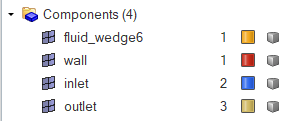Hello guys,
I got a question how to plot surface film coefficient distribution in case where all BCs are wall type with defined temperature values only and fluid is treated as static. I know that turbulent model has to be selected but still I am getting zero values.. Is therea way to omit neccessity of defining inflow or outflow?
<?xml version="1.0" encoding="UTF-8"?>
<?xml version="1.0" encoding="UTF-8"?>
<?xml version="1.0" encoding="UTF-8"?>